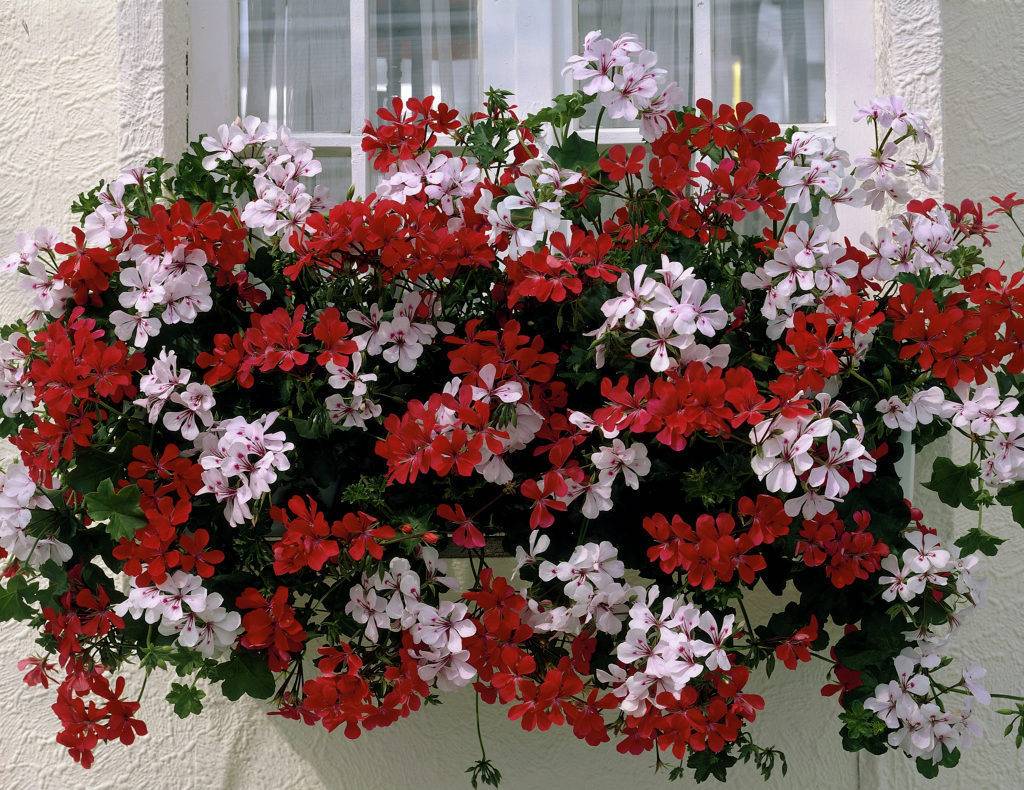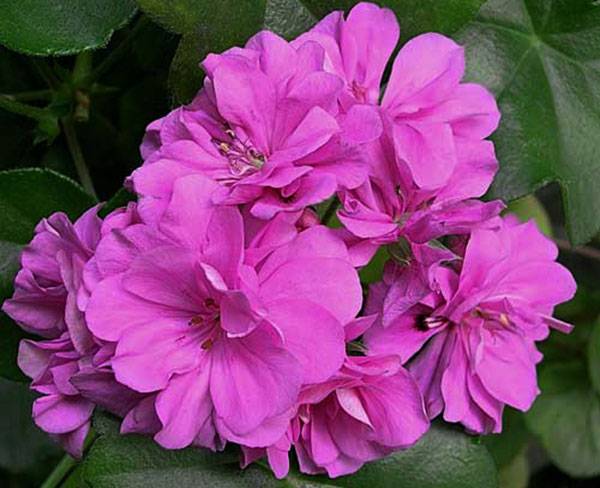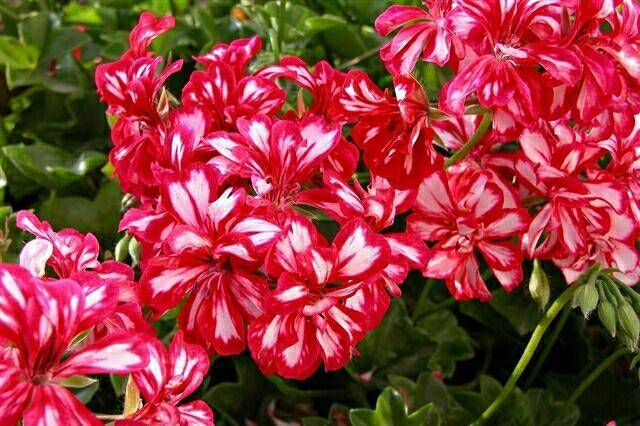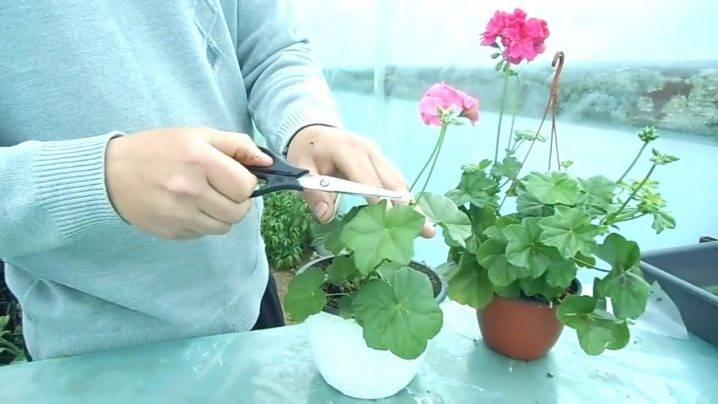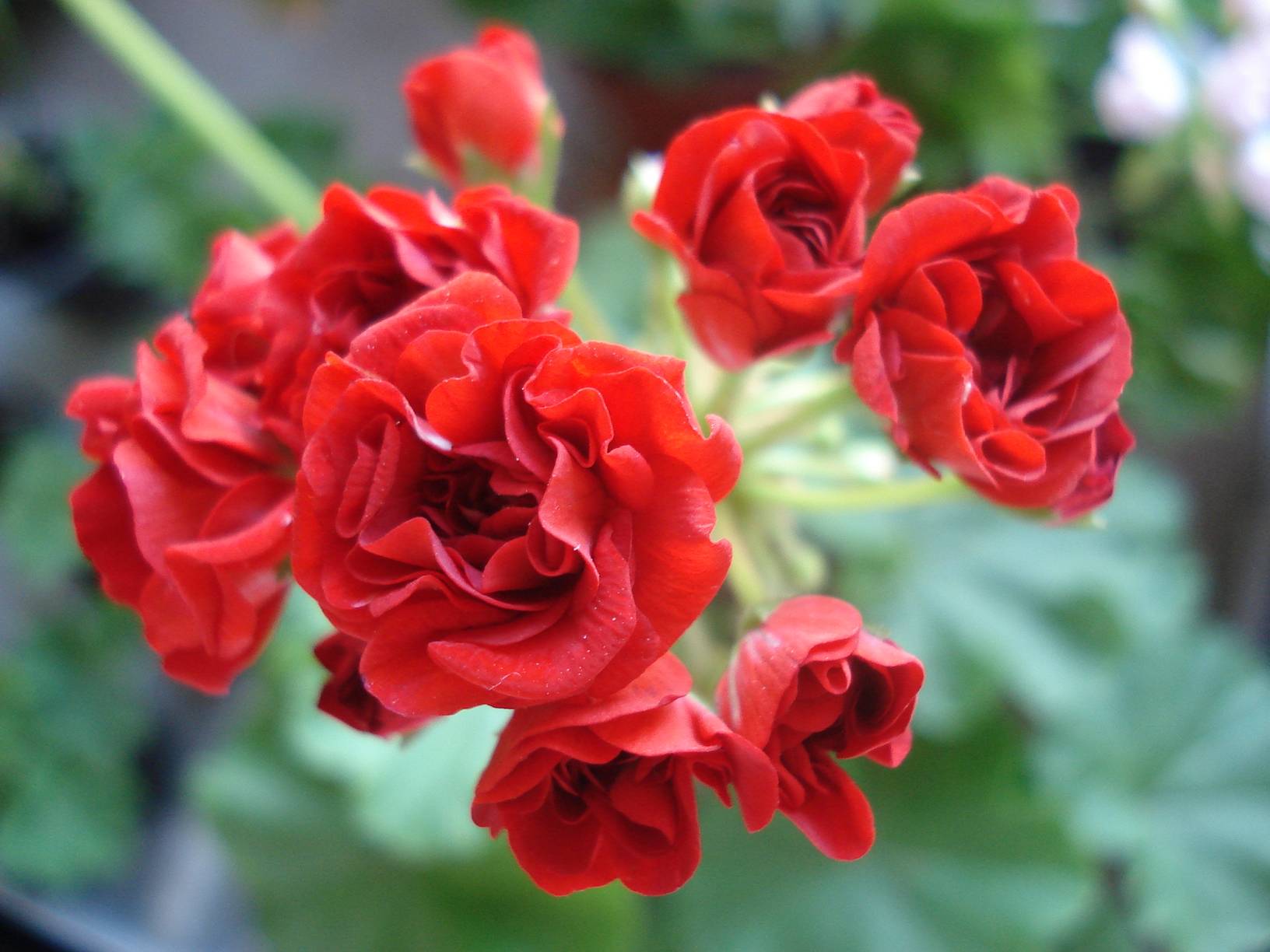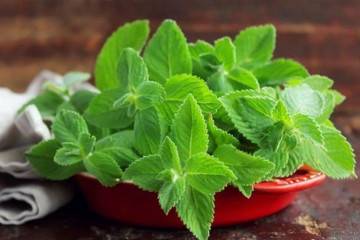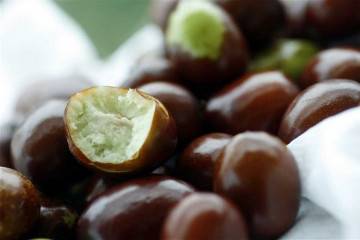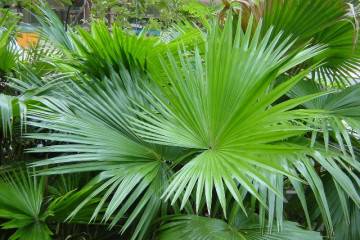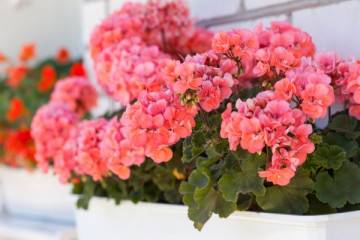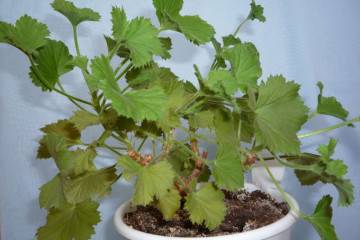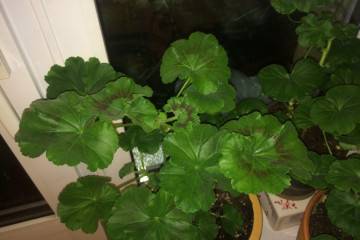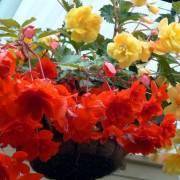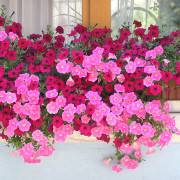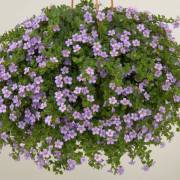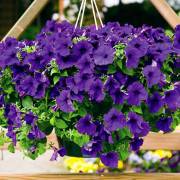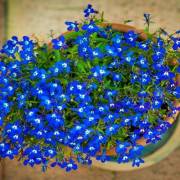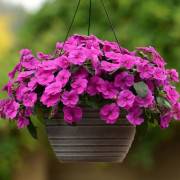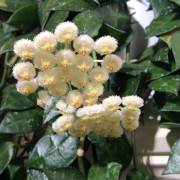Ampel geranium - how to plant and care
Content:
- Ampel geranium - what kind of flower is it, what family it belongs to
- Varieties of indoor plants with names, what they look like
- Caring for ampelous geraniums at home
- Caring for ampelous geraniums in the winter
- Features of flowering pelargonium
- Flower reproduction methods
- Growing problems, diseases and pests
The plant, often found commercially under the name of ampel geranium, is actually a species of pelargonium with drooping long shoots. All kinds of flower colors, simple care and a long flowering period are valuable advantages of a perennial called climbing geranium.
Ampel geranium - what kind of flower is it, what family it belongs to
All varieties of ampelous pelargonium belong to the species Pelargonium peltatum. The plant comes from the south and southeast of Africa. The first description and Latin name was given by Karl Linnaeus in his book of 1753 edition. The name comes from the Latin word pelta, which means sickle-shaped shield. Thus, the exact translation is "pelargonium shield-bearing", since the leaf petiole is attached to the center of the leaf blade.
In its natural habitat, pelargonium climbs the neighboring bushes, prefers dry rocky hillsides. Overgrown plantations can be found along the coastline on well-drained sandy soils.
Brief description, history of origin or selection
The key features of the perennial are long drooping branching shoots and green leaves with five rounded or heart-shaped lobes, an average of 3 cm long, about 5 cm wide.Like zonal pelargoniums, ivy-leaved pelargoniums may have stripes of a lighter or darker shade on the leaves of a sector or ...
The umbrella-shaped inflorescence can carry 2-10 corollas, the petals of which are white, scarlet, lilac, lilac, purple. The flower has bilateral symmetry.
Stems are thin and smooth, 3-10 mm thick, stretching up to 2 m in length. Leaves grow alternately, have stipules up to 7 mm long and up to 4 mm wide, characteristic of zonal species. The petioles of the foliage and the leaves themselves are pubescent or completely naked.
Varieties of indoor plants with names, what they look like
The varieties and varieties of ivy pelargonium are quite numerous, but through the efforts of breeders, they are regularly replenished with interesting new products with even more spectacular flowers.
Summer rain
A variety series with flowers of various colors: white, pink, burgundy, scarlet, lilac. The corolla is simple, has 5 petals. Inflorescence - umbellate from 5-8 buds. Shoots 80-100 cm long. Fleshy dark green leaves have no pubescence, smooth and shiny. Demanding on light, does not tolerate the bay.
Crystal queen
The variety series with different colors of flowers was created specifically for growing in outdoor hanging pots. Tough and durable shoots grow only 20-30 cm and are resistant to wind and rain.
Toscana
This beautiful variety series was bred in European nurseries and differs in that all its varieties have flowers with two-color petals. Corollas are found simple with 5-8 petals, but more often semi-double or double. The habit is compact, the length of the shoots does not exceed 25-30 cm. The bush in the pots forms a compact and symmetrical head. The leaves grow closely to each other with a minimum distance between the petioles. Umbellate inflorescences are directed upwards.
Amethyst
The peculiarity of the variety series is in the pink-lilac rather rare color of flowers, close to the shade of a semi-precious stone. The petals may have burgundy streaks. Corolla - semi-double or double. The variety belongs to variegated. The leaf plate is light green with yellowish veins. The bush is compact with short stems with short internodes.
Decora pink
A beautiful variety with special light green leaves with darker edges, which seem to curl. Looks decorative all year round, even without flowers. It drives out inflorescences on long peduncles of 10-20 or more buds in each. Corolla is simple with five petals of neon pink color.
Ice rose
The real queen among ivy-leaved pelargoniums. The flower is snow-white, double. The peduncle contains a small number of buds, usually 6-8, but due to the very large size of each corolla, it looks unusually impressive.
Rouletta
A graceful variety with an unusual color of flowers. Corolla semi-double bicolor - red-pink. Each petal has a red border, a pink center and red streaks down the center. The plant is compact with short lashes and numerous peduncles of 8-15 buds. Leaves are medium-sized, light green, uniform color.
Caring for ampelous geraniums at home
Unlike zonal and royal pelargoniums, ivy leaves have some features, mainly due to the growing conditions in their historical homeland - in southern Africa.
Illumination and temperature conditions
Without exception, all pelargoniums love sunlight. The best windows in the house for them are southern and eastern. However, since the seedlings are grown indoors, it is worth taking the pots out to fresh air gradually, giving them time to harden.
The optimum temperature for growth and flowering is + 18-22 ° C, but even at much higher temperatures, the bushes will grow well with regular watering. Ivy-leaved varieties can withstand a short-term drop to 0 ° C without any special losses, but they freeze at negative temperatures.
Watering rules and humidity
Watering a cascading plant is necessary only when the soil in the pot dries out to half its height. If you fill in the roots, then they will definitely rot. Ivy-leaved varieties are especially sensitive to waterlogging. Just like all other species, this one does not need spraying even on the hottest days.
Top dressing and soil quality
The soil for planting must be chosen loose and fertile with a neutral alkaline reaction. Geraniums like to have a small amount of clay in the substrate. For looseness, add a third of the sand mixed with vermiculite.
Top dressing with complex mineral fertilizer for indoor flowering plants (for example, Agricola) is necessary during the period of active forcing of buds. It can be given at each watering, diluted in water in a concentration reduced by 4 times. But it is better to feed it every 2 weeks.
Flower container size
Young seedlings are planted in starter pots with a capacity of 0.5 liters. As the root mass grows, the volume increases, but without sudden jerks.Usually, the next pot is chosen 2-3 cm larger in diameter than the previous one. If you give the roots too much freedom, this will negatively affect flowering, the shoots will become reluctant to trail.
Ampel geranium - care and cultivation, pinching, pruning
Shortening shoots should be handled very carefully. In young seedlings, shoots are not shortened, allowing them to gain length and form as many buds as possible.
The first pruning is done in the fall. They shorten the lashes, which had time to become naked and even dry out. Re-pruning is done in the spring, shortening the shoots that have stretched out over the winter, giving the crown a neat shape. In summer, the bushes are not touched, allowing them to grow freely.
Caring for ampelous geraniums in the winter
In order to get an abundantly flowering plant next year, it is necessary to observe several mandatory wintering rules:
- Cool temperature in the range of + 5-12 ° C.
- Bright but diffused lighting.
- Rare accurate watering at the root, without touching foliage and shoots.
Features of flowering pelargonium
The duration and splendor of flowering directly depends on the health and age of the plant. Seedlings of the first year of life bloom 9-12 weeks after germination. At first, the number of flowers will be small, but will increase with regular feeding.
A period of activity and rest
Adult ivy-leaved pelargoniums bloom from March to October. With a sufficient supply of potassium and phosphorus, there will be no breaks in forcing the buds. If summer air temperatures are above + 35 ° С, then due to the heat there may be a pause. The dormant period, when the flower pot needs to be sent to a cool place, lasts from the end of November to the end of February.
Types and shape of flowers
The variety of ivy-leaved pelargoniums is very large. Simple 5-petal corollas most often indicate that this is a commercial variety with robust genetics and no variation.
The varieties bred by breeders are much more diverse. Their flowers are semi-double and double, similar to tiny roses. The colors can be monochromatic, two-tone, with a gradient, colored veins, a border. The larger the corollas, the smaller their number forms an umbrella-shaped inflorescence. Usually there are from 2 to 20 buds on one peduncle, depending on the variety.
Flower reproduction methods
Most of the ivy pelargonium varieties are easy to propagate by seed and cuttings. However, some varieties, when propagated by seed, do not give offspring exactly the same as the appearance of their parents, so they can only be cut by cuttings.
Seed propagation
The seeds of various ivy-leaved pelargoniums, with all the abundance of flowering, are more expensive than their zonal relatives. The reason is that only a few viable seeds can be set on one bush. They retain their germination capacity on average up to 3 years, but it decreases every year, so it is recommended to purchase only fresh planting material.
Sowing is carried out in February-March, deepening the seeds by 3-5 mm, no more. Seedlings can be very uncooperative: from 7 to 30 days. All this time, the container must be kept on a light windowsill at a temperature of + 22-24 ° C, preventing the soil from drying out.
The picking of seedlings is carried out at the stage of 2-3 true leaves. For each plant, the starting pot should not be more than 0.5 liters. At the bottom, be sure to put at least 3 cm of drainage from expanded clay or small pebbles.
Propagation by cuttings - step by step method
The optimal time for cutting apical cuttings is August. Choose healthy shoots, preferably without buds, with 3-4 leaves.
It is impossible to root the cuttings in water, only in the substrate, since waterlogging leads to decay. The optimal composition of the mixture: 1 part of fertile soil, 3 parts of vermiculite, 2 parts of peat.
The cut branches are dried for 1-2 hours so that the cut has time to dry out. Then they are planted in pots, keeping some distance between them. It usually takes 3 weeks to root.
You need to take care of it like an adult plant. The climbing geranium will bloom next year.
Growing problems, diseases and pests
If geranium leaves turn yellow, this may indicate that the root system has outgrown the pot. Usually, in such cases, the tips of the roots are visible from the lower drainage holes. A transplant will solve the problem. The new pot should be 2-3 cm larger in the diameter of the previous one.
Lack of flowering is a bad sign. Perhaps a fungal disease has settled on the plant, but more often the reasons are a lack of sunlight and nutrition. It is necessary to move the pot to a more lighted place, and fertilize the next time you water.
In room conditions, the ground part can be treated with Fitoverm. The drug has a faint odor, disappears quickly, and acts on all common pests. Processing is carried out with an interval of 5-7 days 2-3 times.
In the open air, it is better to use a more concentrated preparation - "Aktara". It can be used for spraying the ground part as well as for watering. Usually, a one-time treatment is enough, but if necessary, it can be repeated at weekly intervals.
The problem of fungal diseases plagues plants that are watered too often. It is extremely difficult to deal with them. If the bush is large enough, then the remaining healthy branches are selected and rooted. The young plant is dried, then watered with Fitosporin, and Topaz is suitable for spraying.
Growing ivy geranium is not difficult. You can always choose a shade to your taste. With proper agricultural technology, the life expectancy of the bushes is not limited, and if necessary, they can be easily rejuvenated.
